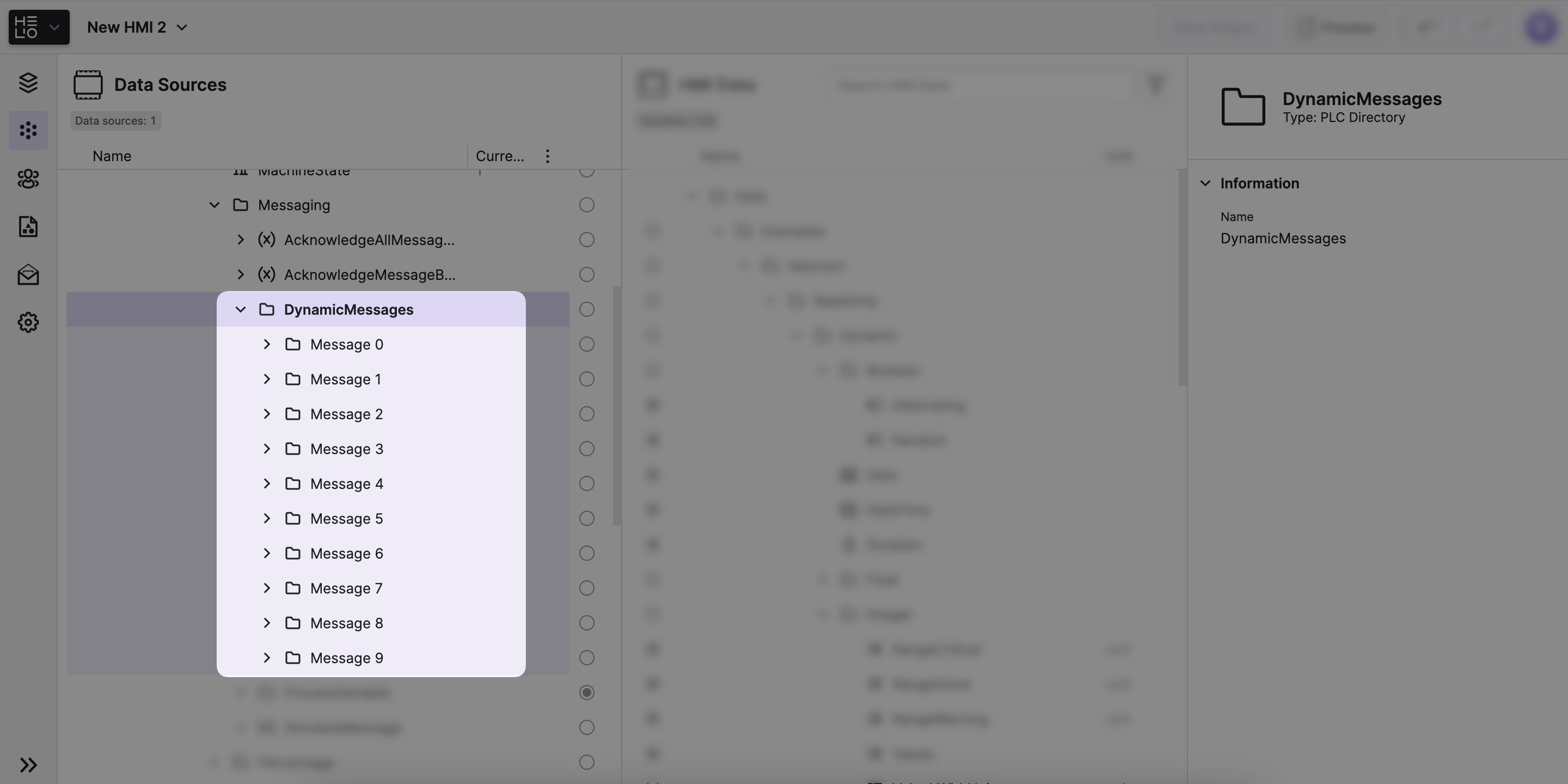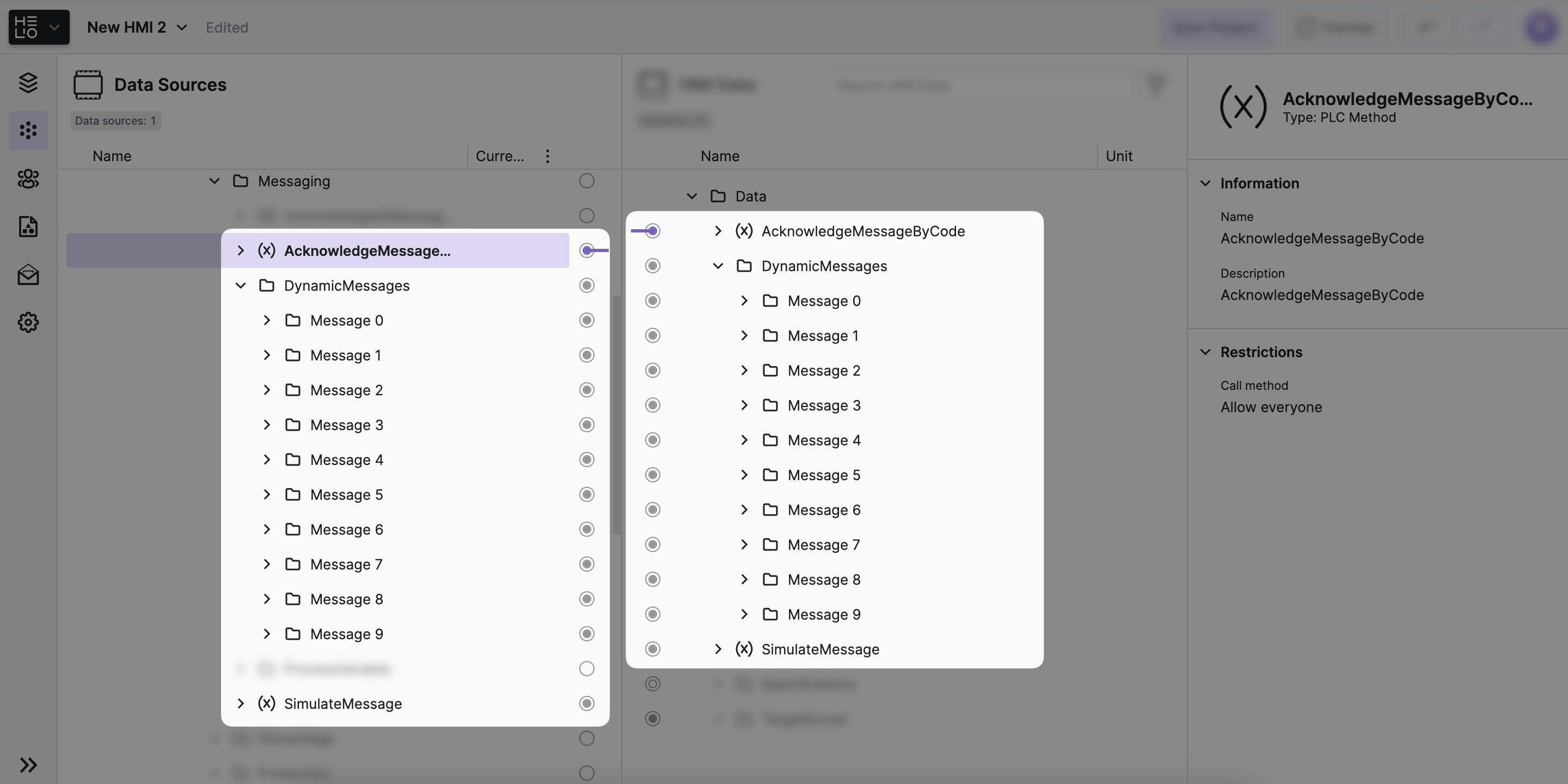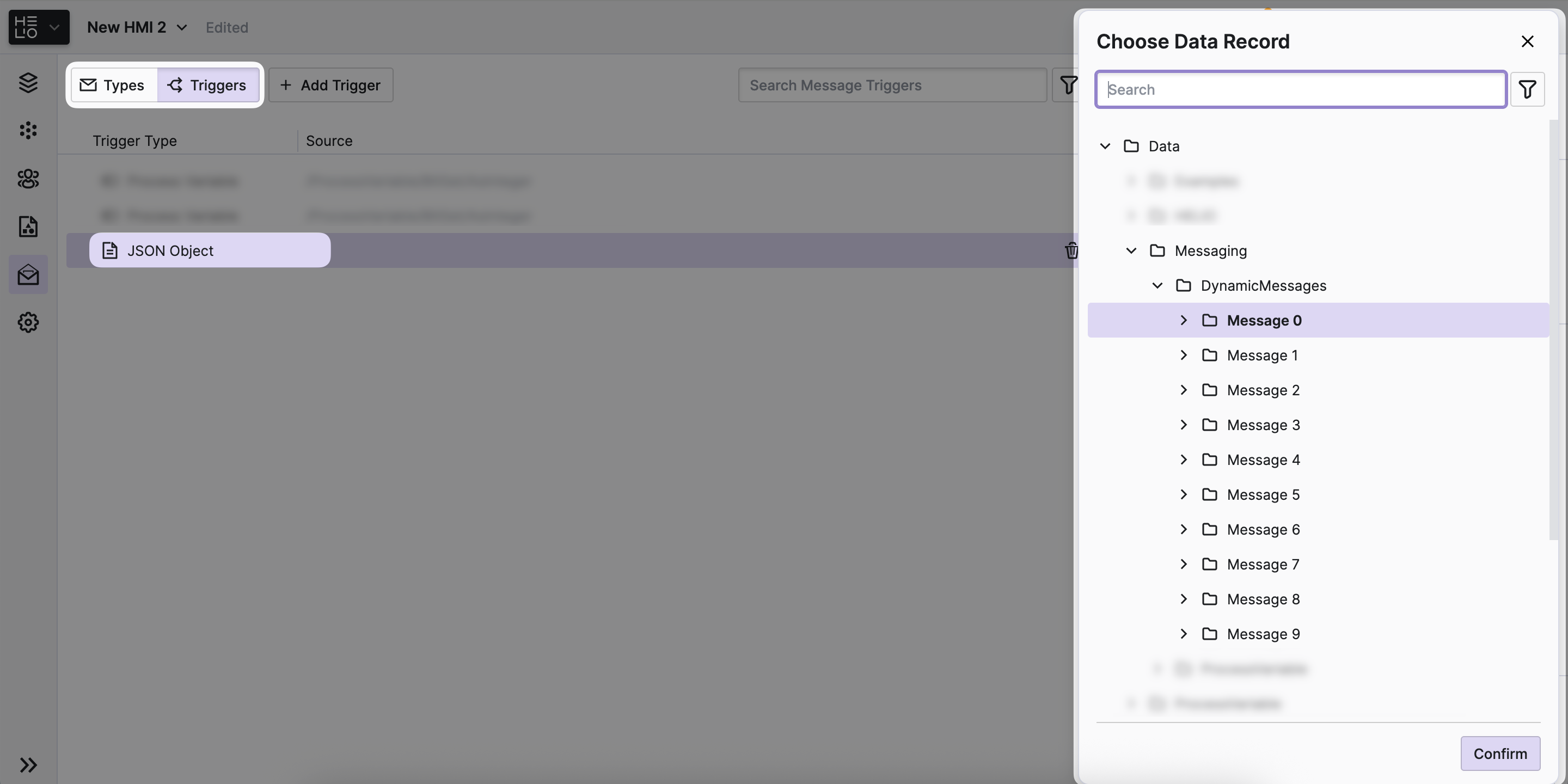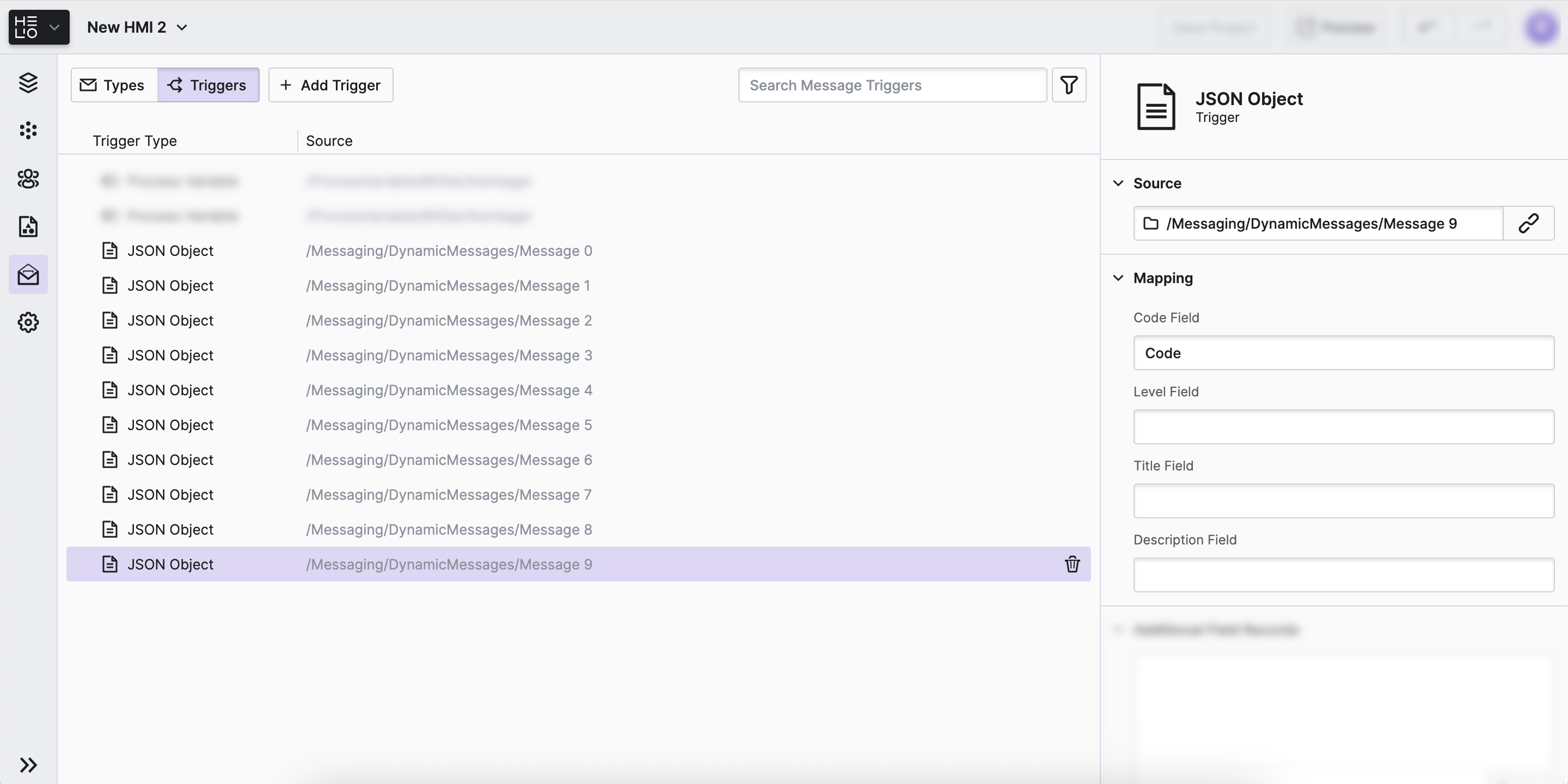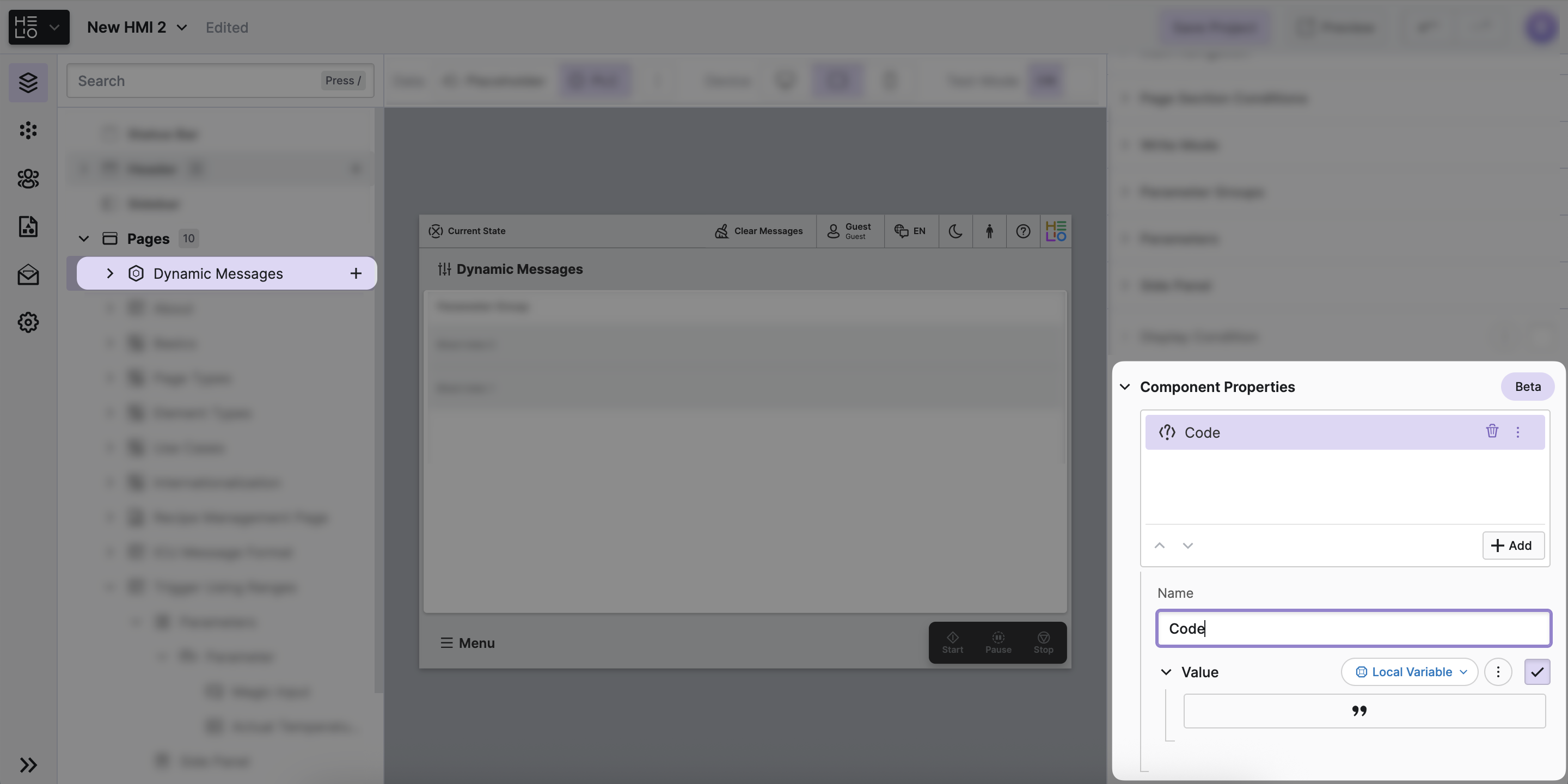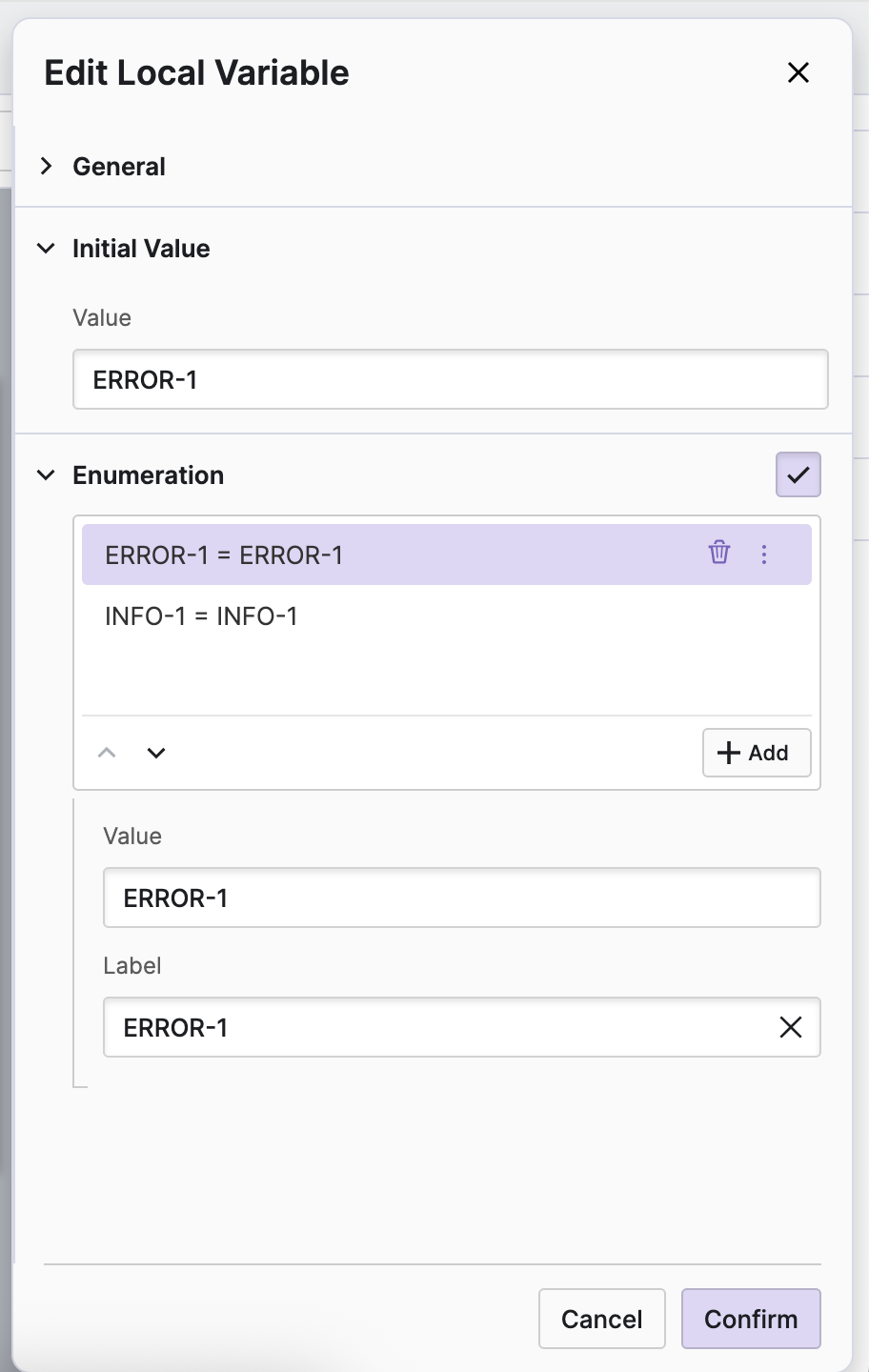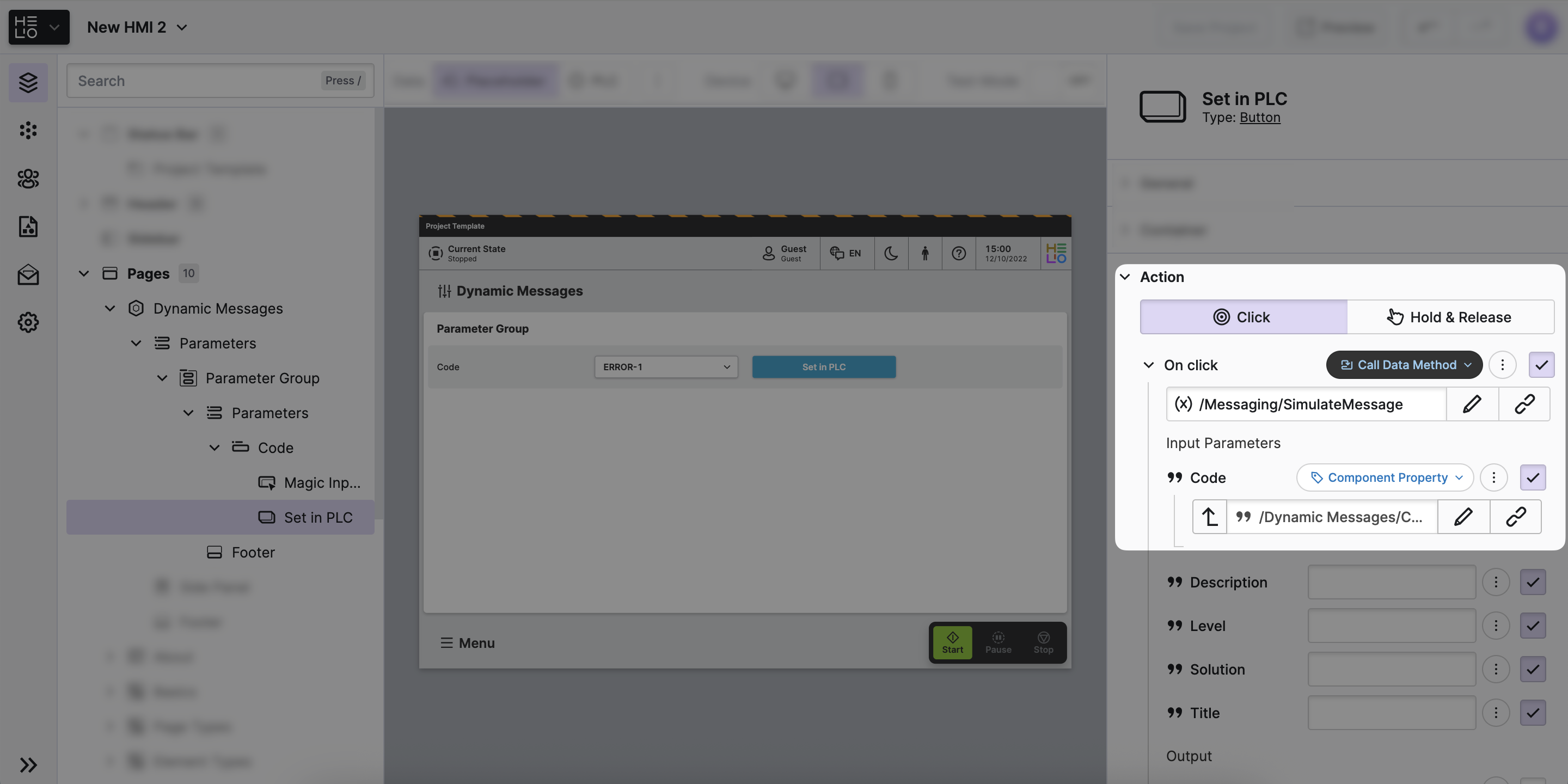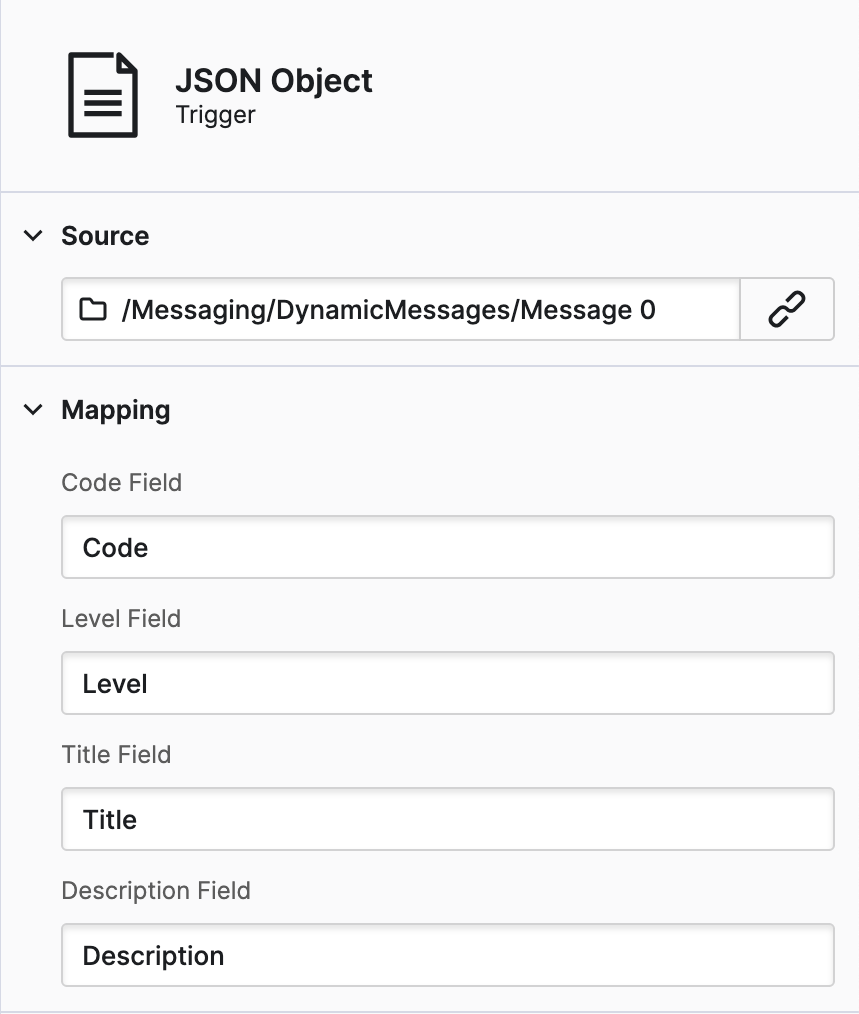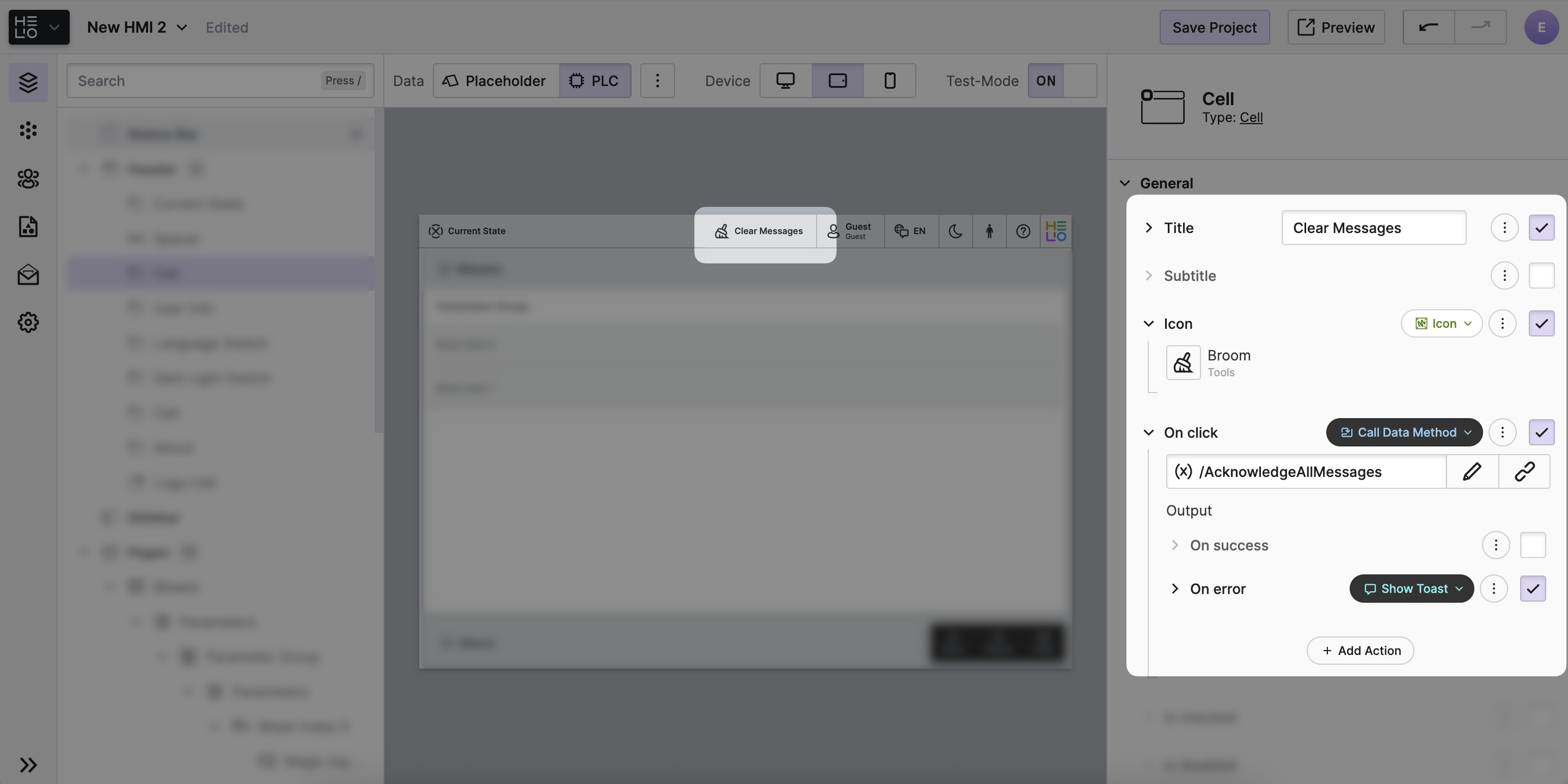Trigger Messages Using Structured Objects (JSON Objects)
In the previous steps, we learned how to trigger messages by watching numeric variables or setting the bits of a variable. In more advanced scenarios these basic ways of triggering messages can be too limited.
For example:
- You have a huge amount of possible
Message Types. - You want the PLC to have control over message metadata like
Level,Title,Description, etc. - You want to attach additional metadata to messages from your PLC.
In such scenarios, it is the PLC that actually provides the message metadata using a
structured object. Let's find out how we can use the trigger called JSON Object
to make this all work.
1. What is a Message Object?
First, let's clarify what Message Objects actually are. Each message is a data
structure that can trigger messages and needs to adhere to
the following rules:
A Message Object…
- Can be represented as a string variable that provides all of the message data using a JSON payload.
- Must contain a
Codevariable that will actually trigger the message. - Can optionally include additional variables that can be be used to define message metadata.
Code (required)
Code (required)- Its value represents the Message Code of the message that shall be displayed.
- Must be of type String. But can of course be used to represent numerical values as well.
- Signals HELIO to display a message, if the variable is set to a non-empty string e.g.
WARN-001 - Signals HELIO to remove the message, if the variable is set to an empty string again.
- Should best be called
Code, but you can actually call it whatever you like.
Level (optional)
Level (optional)- Is used by HELIO to determine the level of the message. See Messaging Basics: Storage, Codes and Levels for more details…
- Must be of type String.
- Allowed values:
Info,Warn, orError.
Title (optional)
Title (optional)- Is displayed by HELIO in the Message Dialog as the title of this message.
- Must be of type String.
- Can be a Translation Key. HELIO will translate it automatically.
Description (optional)
Description (optional)- Is displayed by HELIO in the Message Dialog as the description of this message.
- Must be of type String.
- Can be a Translation Key. HELIO will translate it automatically.
Legacy Support: Directory With Child Variables
In previous HELIO versions (25.1 and below), structured objects could be represented as a data directory with message properties as child variables. This is still supported in HELIO 25.2.0 and later versions to support older project configurations without breaking existing projects. For newer projects, use the new Dynamic Message Triggers introduced in HELIO 25.2.0. They allow you to select a variable for each message property instead of specifying a property name, which is a bit more secure since HELIO can verify if this variable still exists.
Outlook: Simplified Message Object Configuration via Structs/Extension Objects
Custom data types and structures, also known as extension objects in OPC UA, will undoubtedly streamline the configuration of such object triggers. We've already started foundational efforts to make this possible in the future. so expect a more simplified setup of message trigger for structured objects in future versions of HELIO.
2. Import Message Objects from Your PLC
- Locate the
Examples/Concrete/Messaging/DynamicMessagesVariables
Locate the variables and methods in the Data Source Explorer.
You should spot them in this directory:
Examples/Concrete/Messaging/DynamicMessages.
- Import Variables & Methods
Let's import the variables and methods into the project so that we can use them in our HMI.
- First of all import the whole
DynamicMessagesdirectory as it contains our dynamic message objects. - We're also going to use the two methods
SimulateMessageandAcknowledgeAllMessages. So make sure you import those too.
Why Do We Need Those Methods?
Both methods are only needed for simulation purposes:
SimulateMessagetells our Playground PLC to fill one of our dynamic objects, so we can simulate a message appearing on our PLC.AcknowledgeAllMessageswill cause our Playground PLC to clear all the active messages in theDynamicMessagesdirectory.
3. Setup Your Triggers
Now that we've got our structured objects, let's define the triggers that will make sure changes to these objects will actually trigger a message.
- Define Your First Trigger
Switch to the Message Triggers View, click
the Add Type action and choose JSON Message as a trigger type.
- Configure the Trigger
The main difference from previous triggers is that we do not hardcode a specific message code for each trigger.
Instead, we will set the Source property of our trigger, which needs to
point at our structured object. Select the first message object called Message 0
in the Dynamic Message directory that we imported in the previous steps.
Now, we need to map the properties of the Message 0 object to the fields
of our message. Enter the property name Code into the Code Field to
instruct HELIO to look into the object and retrieve the message code from
the Code property.
When Will Messages Appear?
Once Code changes from an empty to a non-empty string e.g. WARN-001.
- Add Additional Triggers
4. Create a Page to Trigger Messages
The excitement is building because we're all set to start sending messages to our HMI. All we need to do is create a small page to simulate the whole thing. Let's get started!
- Add a
ParameterPage
First things first, we need to create a page. To keep it simple, we're just going to create a basic Parameter Page.
So switch to the Content View and add a Parameter Page.
- Turn the Page Into a Component to Add Local State
In order to be able to send multiple Message Codes, we first have to turn the page into a Component (see HELIO Components to learn more about Components).
Define a Component Property named Message Code and add ERROR-1 and INFO-1 as possible values. This will allow
us to send these values to the PLC.
- Add a
Magic Inputto Control theMessage Code.
- Add a
Magic Inputto control the Message Code that shall get sent to the PLC and set its value property to the Component Property that we've just defined. - Add a
Buttonto call theSimulateMessagemethod.
5. Simulate Our First Messages
Let's Get Those Messages Fired Up!
- Switch to
PLC Modeto make sure you will be writing to the actual PLC. - Switch to
Test Modeso you can toggle the inputs. - Click on the button to simulate messages.
Your HMI should behave something like this:
6. Map More Object Metadata
So far HELIO only receives the Code from the PLC. But we can provide more message
metadata from the PLC.
- Map More Message Fields
Go back to your trigger definition and make sure all of the object's properties will get mapped from the PLC to the fields of the message:
- Locate the
Mappingsection. - For each field of the message (
Title,Description, …) enter the name of the structured object property that will provide the metadata.
Once this is done, your trigger configuration should look like this:
7. Removing Messages
Now that we have messages in our Active Messages list, we need to ask ourselves how those messages will become inactive. How are messages resolved and moved into the Message Archive?
When Will Messages Disppear?
Once the Code changes back from a non-empty string e.g.
WARN-001 to an empty string.
So the PLC is able to remove messages from the list by resetting the Code
property of the object to an empty string. Once this is detected,
HELIO will mark this message as archived.
In real life, this might be caused by:
- The actual error or situation that caused the error has been resolved, so the message can be archived.
- There is an additional hardware button to acknowledge all messages
which can be pressed by operators. This hardware acknowledgement will be
used by the PLC to reset all the message objects and set their
Codeattribute to an empty string.
For our simple test HMI:
We will simulate this process by calling
the AcknowledgeAllMessages method. This resets all objects in the
DynamicMessages directory and sets their Code
attribute to an empty string.
- Add a Header Cell
Let's add a simple Header Cell to trigger the method:
- Add it to the header of your HMI.
- Set its
TitletoClear Messages. - Choose a nice
Iconthat gets the message across, e.g.Broom.
- Configure
On clickProperty
Activate the On click property and choose the Call Data Method Action
as its type:
- Clear Some Messages
Switch to test mode and click Clear Messages. Any active messages that
you triggered before should no longer appear.
You've learned how to trigger and archive messages using structured objects.
However, there is another way! So, if you're interested in triggering dynamic messages using property variables, stick around for the next guide.
